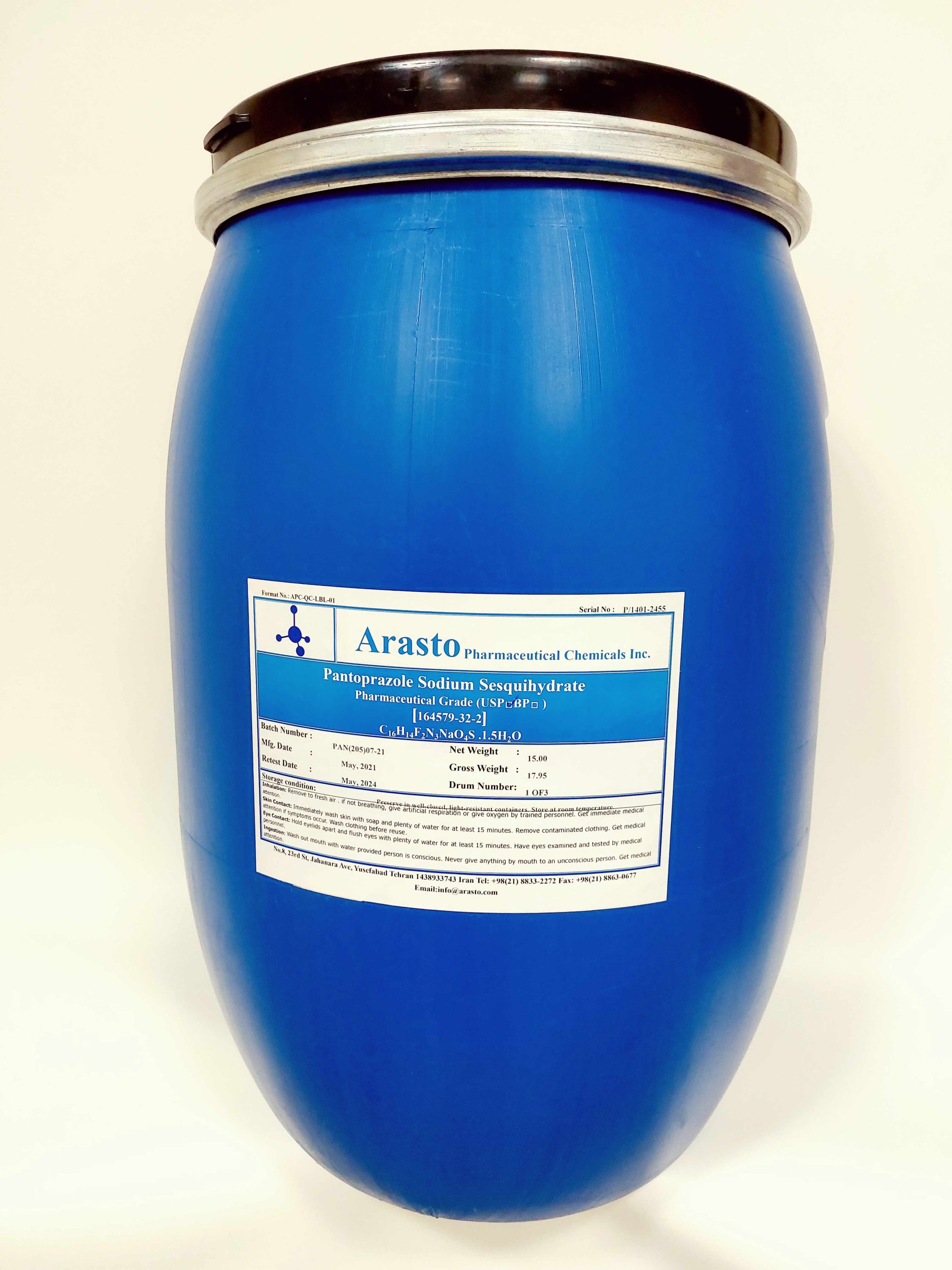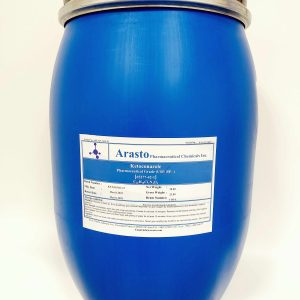Description
Description
(USP 44)
- Drug Substance General Information (ICH 3.2.S.1)
1.1. Nomenclature(ICH 3.2.S.1.1)
International non-proprietary name: Pantoprazole (Brand Name: Protonix, Somac, Pantoloc, Pantozol, Zurcal, Pan, Rifun, Inipaup)
Compendial name: Pantoprazole
Chemical name: 5-[Difluoromethoxy)-2[[3,4-dimethoxy-2-pyridinyl)methyl]sulfinyl] bezimidazole sodium salt ,sesquihydrate
Arasto’s code: PAN
CAS Registry Number: [164579-32-2]
1.Drug Substance General Information (ICH 3.2.S.1)
1.2. Structure (ICH 3.2.S.1.2)

Empirical formula: C16H14F2N3NaO4S.3/2 H2O
Molecular Weight: 432.37 g/mol (or 864.76 for PAN–Na+.3H2O)
- Drug Substance General Information (ICH 3.2.S.1)
1.3. General Properties (ICH 3.2.S.1.3)
Pantoprazole is a white to off-white crystalline substance. It is orally administered for short-term treatment of erosive esophagitis associated with gastroesophageal reflux disease, maintenance of healing of erosive esophagitis and pathological hypersecretory conditions including Zollinger-Ellison Syndrome. It is soluble in water and polar organic solvents such as alcohols, DMF and DMSO). The pKa of the pyridine amine function has been reported between 3.8 and 3.92 (http://www.cedrugstorenews.com/). The pKa of the benzimidazole amine has been reported at 15.76 (http://www.drugbank.ca/drugs/DB00213). Its log P has been reported to be 1.27 (http://pharmacycode.com/Pantoprazole_Sodium.html). Stability in aqueous solution is pH-dependent. The rate of degradation increases with decreasing pH. Like all other proton pump inhibitors, undergoes Pummerer Rearrangement and decomposes to numerous other products with characteristic deep purple color (Karimian, K. et al, “Recent Advances in Proton Pump Inhibitors”, Invest. Drugs, 2000, 3, 1064).At ambient temperature, the degradation half-life is approximately 2.8 hours at pH 5.0 and approximately 220 hours at pH 7.8. Pantoprazole sodium is stable in base. At pH 5.0 at ambient temperature, the degradation half-life of Pantoprazole is approximately 2.8 hours and at pH 7.8 approximately 220 hours. LD50 values for Pantoprazole sodium in rat were found to be: IV 390 mg/kg , oral 700 mg/kg (http://www.pulsus.com/cddw 2003/pantoloc.htm).
The determination of purity and assay of APIs require comparison of the product with their respective Reference Standards (RS) and Related Compounds (RC or known impurities). Accordingly, ICH regulations on the purity and assay of reference standard and related compounds are clearly defined and must be followed by drug substance and drug product manufacturers.
According to ICH Q7, 11.1 there are 3 types of standards. This is summarized in the following chart and discussed in detail below.

The impurities provided in the following table represent Secondary Reference Standards (SRS) that are prepared in-house by synthesis or by isolation. Each SRS has undergone extensive characterization ( IR, UV, 1HNMR, 13CNMR. Mass Spec) and determination of its purity and assay (HPLC). For specification of the SRS of those products that have a monograph, the SRS is compared with a pharmacopoeia Primary Reference Standard (UV, HPLC retention time). For specification of those products that do not have a monograph (known as House Primary Standard), we compare their UV ε or ג /max , IR major absorptions, 1HNMR d (ppm) , 13 CNMR d (ppm) or HPLC retention time with values reported in the chemical literature for these compounds.

- Reference Standards (ICH 3.2.S.5)
5.1. Primary and secondary reference standards (API)
Primary Reference Standard for pantoprazole sodium is available from United States Pharmacopoeia. We will use a Secondary Reference Standard (also known as House Standard or Working Standard) for direct control of all batches of pantoprazole sodium .
As per ICH (Q7, 11.1) and ICH (Q6, 2.11, 3.2, 3.3)the Secondary Reference Standards must be examined for their identity by proof of structure (characterization), assay and purity and specification. Furthermore, ICH Guideline on the Preparation of Common Technical Document (Q4M), requires that the data obtained from characterization, assay and purity and specification must be included in section 3.2.S.3.2 for Related Compounds and section 3.2.S.5 of the DMF for the API. To this end, the Secondary Reference Standards of the API pantoprazole sodium has undergone extensive characterization (UV, IR, 1 H NMR, 13C NMR, Mass Spec) to assure their identity, assay and purity (HPLC and/or titration) and specification (comparison of its HPLC retention time and UV ג/max with USP Primary Reference Standard.
The Secondary Reference Standard for pantoprazole sodium is produced from a released batch of pantoprazole sodium by subjecting it to an additional crystallization from the final solvent system used in the production of the API to avoid the possibility of other polymorph formation.
SPECIFICATION OF ANALYSIS
| Product: Pantoprazole Sodium Sesquihydrate | CAS No.: 164579-32-2 | Spec. No.: APC-QC-SPEC-391-00 | ||
| Issue Date: Apr, 2023 | Valid up to: Apr, 2024 | Reference: USP44 | ||
| Tests | Specifications | |||
| Description | White to off-White powder. | |||
| Solubility | Freely soluble in water, in methanol, and in dehydrated alcohol, practically insoluble in hexane and in dichloromethane. | |||
| Identification | A: Infrared Spectroscopy B: The retention time of the major peak of the Sample solution corresponds to that of the standard solution, as obtained in the assay. C: Sodium. | |||
| Water Determination | Between 4.5% and 8.0% | |||
| Residual Solvents | Acetone: Max. 5000 ppm (Class ІІІ) Ethyl acetate: Max. 5000 ppm (Class ІІІ) n- Butanol : Max. 5000 ppm(Class III ) Dichloromethane: Max. 600 ppm (Class ІІ) Toluene: Max. 890 ppm (Class II) | |||
| Related compounds (Test 2) | Related Compound A: NMT 0.20% Related Compound B: NMT 0.15% Related Compound C: NMT 0.10% Related Compound D&F: NMT 0.20% Related Compound E: NMT 0.10% Any other individual impurity: NMT 0.10% Total impurities: NMT 0.5% | |||
| Assay | 98.0% to 102.0% (on the anhydrous basis) | |||
| Description | White to off-White powder. | |||
| Prepared by: M. Shahbazi, B.Sc.Chem. | Checked by: A. Forghani, B.Sc.Chem. | |||
| Approved by: F. Javadizadeh, M.Sc.Chem. | ||||
| Storage: Preserve in well-closed, light-resistant containers. Store at room temperature. | ||||





